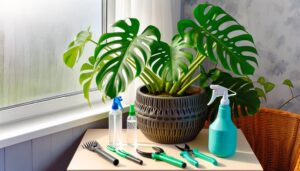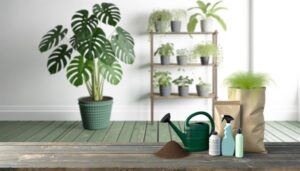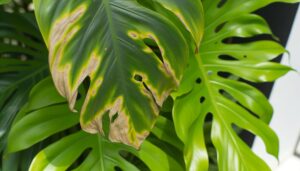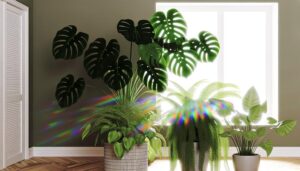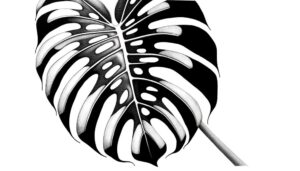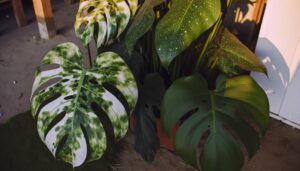Comparison: Split Leaf Philodendron Vs Monstera Deliciosa
The Split Leaf Philodendron (Thaumatophyllum bipinnatifidum) and Monstera Deliciosa both hail from tropical Central and South America. Split Leaf Philodendron displays deeply lobed, pinnatifid leaves, thriving in dense understory habitats with arborescent growth.
In comparison, Monstera Deliciosa showcases fenestrated, perforated leaves and a hemiepiphytic climbing pattern. Both plants prefer bright, indirect light and well-draining soil but have distinct watering needs.
Importantly, both are toxic to pets. Split Leaf Philodendron's terrestrial stability contrasts with Monstera's aerial root-based ascent.
For a detailed exploration of differences and care tips, more insights await.
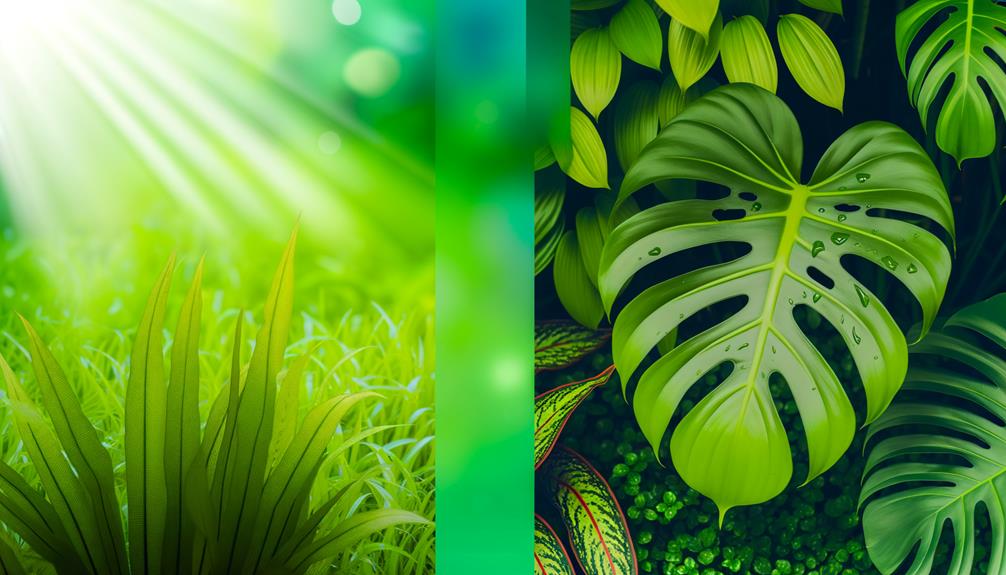
Key Takeaways
- Split Leaf Philodendron has deeply lobed leaves, while Monstera Deliciosa features fenestrated leaves with characteristic perforations.
- Monstera Deliciosa climbs using aerial roots, whereas Split Leaf Philodendron exhibits a self-supporting, arborescent form.
- Both plants thrive in bright, indirect light but Split Leaf Philodendron prefers consistent moisture; Monstera needs drying out between waterings.
- Both species require well-draining, organic-rich soil and are susceptible to pests like aphids, spider mites, and scale insects.
- Both plants are toxic to pets due to insoluble calcium oxalates and needle-like crystals.
Origin and Habitat
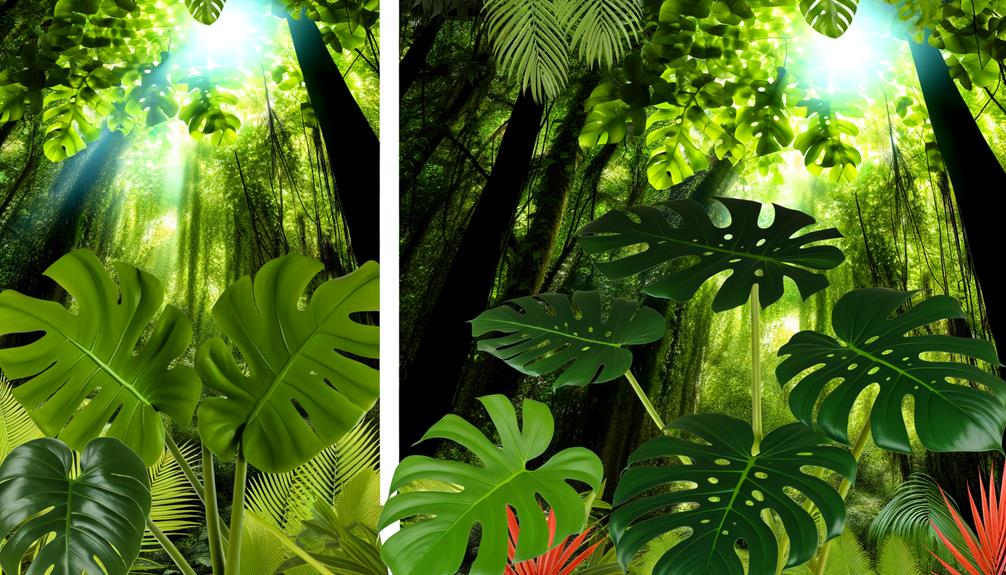
Although both the Split Leaf Philodendron and Monstera Deliciosa originate from tropical regions of Central and South America, their specific native habitats exhibit distinct ecological characteristics which influence their growth patterns and morphological features.
The Split Leaf Philodendron, primarily found in the dense understory of Brazilian rainforests, thrives in shaded, humid environments, utilizing its aerial roots for stability and nutrient absorption.
In contrast, Monstera Deliciosa is native to the rainforests of southern Mexico and Panama, where it adapts to varying light conditions by climbing trees using its robust, adventitious roots.
These different habitats result in unique adaptations, where the Split Leaf Philodendron shows a preference for low-light conditions, while Monstera Deliciosa demonstrates versatile climbing abilities and tolerance to diverse light intensities.
Leaf Structure
The distinct ecological niches of the Split Leaf Philodendron and Monstera Deliciosa are mirrored in their leaf morphology, where each species exhibits unique structural adaptations tailored to their specific environments.
The Split Leaf Philodendron (Philodendron bipinnatifidum) features deeply lobed, pinnatifid leaves, which enhance light capture efficiency and facilitate air circulation. Conversely, Monstera Deliciosa showcases fenestrated leaves with characteristic perforations and splits, optimizing light penetration to lower foliage and reducing wind resistance.
These morphological traits are evolutionary responses to their native habitats: the Philodendron's dense underbrush and Monstera's forest canopy.
Both species display glossy, leathery leaf textures, which minimize water loss and confer durability, essential for their survival in humid, tropical ecosystems.
Growth Patterns
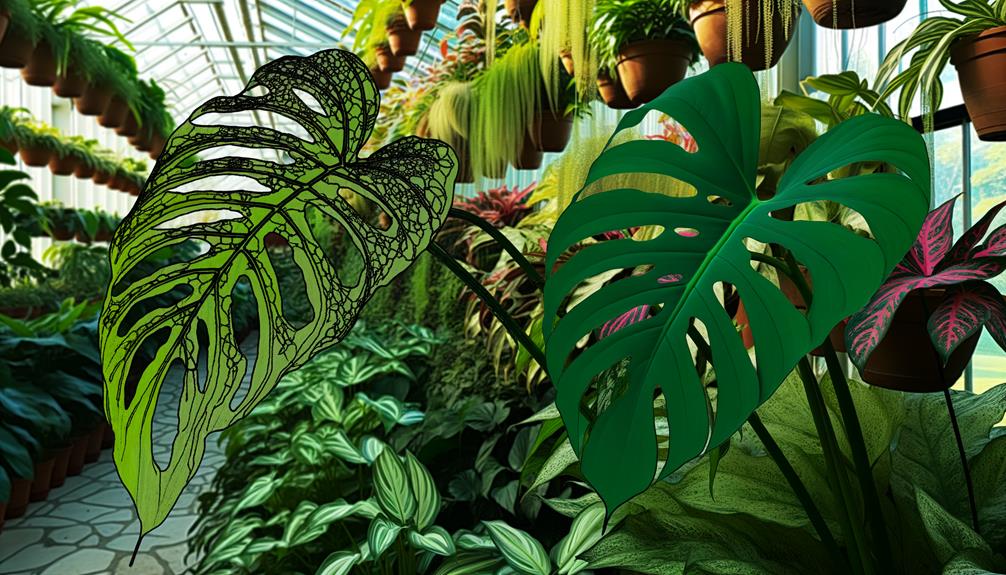
Distinguishable by their distinct growth habits, the Split Leaf Philodendron (Philodendron bipinnatifidum) typically exhibits a self-supporting, arborescent form, while Monstera Deliciosa demonstrates a climbing, hemiepiphytic growth pattern.
The former develops a robust, tree-like structure, characterized by thick, woody trunks and a broad canopy. It thrives terrestrially, anchoring itself firmly into the soil.
Conversely, Monstera Deliciosa employs aerial roots for vertical ascension, often utilizing adjacent structures for support. This hemiepiphytic nature allows it to inhabit both soil and arboreal environments.
Morphologically, the Monstera's internodes elongate significantly as it climbs, facilitating leaf dispersal and maximizing photosynthetic efficiency. In contrast, the Philodendron maintains compact internodes, fostering a more condensed and sturdy growth architecture.
Light Requirements
The Split Leaf Philodendron and Monstera Deliciosa both thrive in bright, indirect light, though they display notable adaptability to lower light conditions.
Monstera Deliciosa, with its fenestrated leaves, exhibits best growth under filtered sunlight, while the Split Leaf Philodendron, possessing broader leaf morphology, can sustain its photosynthetic activity even under moderate shade.
Understanding these light requirements is essential for maximizing the health and vigor of each species in varying indoor environments.
Ideal Sunlight Conditions
Ideal photosynthetic activity for both Split Leaf Philodendron and Monstera Deliciosa requires bright, indirect light conditions. These aroids thrive in environments that mimic their natural understory habitat in tropical rainforests, where they receive filtered sunlight through the canopy.
Direct sunlight can lead to photoinhibition, resulting in chlorosis and scorching of the leaves. Optimum light exposure ensures strong morphological development, including prominent foliar fenestrations in Monstera Deliciosa and deeply lobed leaves in Split Leaf Philodendron.
Light intensity affects chloroplast efficiency and stomatal conductance, important processes for maximizing the rate of photosynthesis. Monitoring light conditions can prevent etiolation, preserving plant vigor and aesthetic appeal.
Using sheer curtains or placing the plants near east or north-facing windows can achieve the necessary light conditions.
Adaptability to Shade
While both Split Leaf Philodendron and Monstera Deliciosa thrive in bright, indirect light, their ability to adapt to lower light conditions highlights their resilience in less than ideal environments.
The Split Leaf Philodendron (Philodendron bipinnatifidum) shows significant shade tolerance, thanks to its large, deeply lobed leaves that enhance photosynthetic efficiency in limited light. On the other hand, Monstera Deliciosa, with its fenestrated foliage, also demonstrates impressive adaptability, although its growth rate may slow down in reduced light.
Importantly, both species maintain their structural integrity, even though they may stretch if there is a lack of adequate light. Understanding these plants' light needs is essential for maximizing their beauty and overall health, promoting strong growth even in indoor spaces with soft light.
Watering Needs
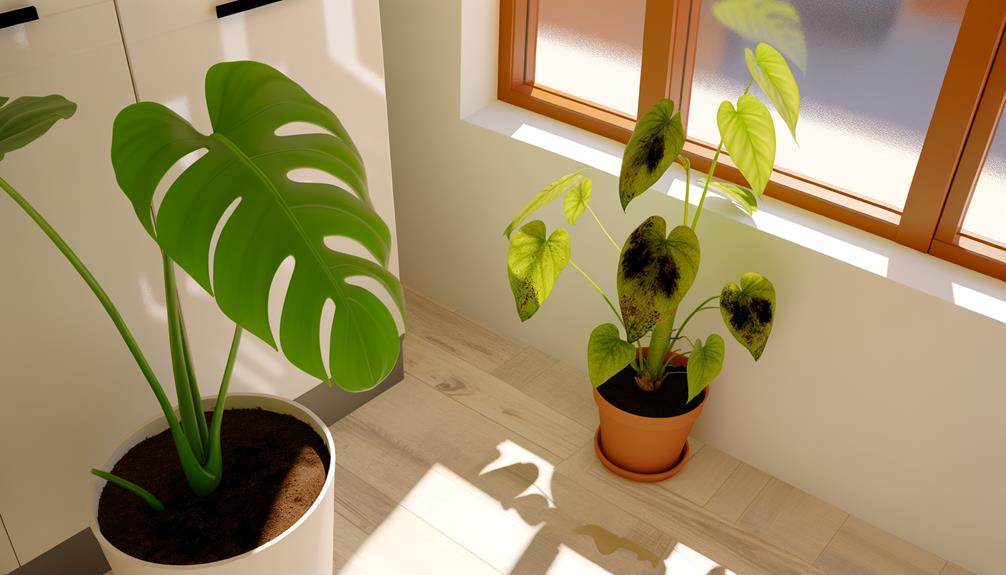
When examining the watering needs of the Split Leaf Philodendron and Monstera Deliciosa, it is important to take into account their frequency of watering, soil moisture preferences, and signs of overwatering.
The Split Leaf Philodendron typically prefers consistent moisture, whereas Monstera Deliciosa favors a drying-out period between waterings.
Both species exhibit specific physiological markers of overwatering, such as yellowing leaves and root rot, which necessitate careful monitoring of soil conditions.
Frequency of Watering
Determining the best watering frequency for Split Leaf Philodendron and Monstera Deliciosa requires an understanding of their native habitats and physiological adaptations to moisture availability. Both species thrive in tropical environments, yet their watering needs can differ slightly due to their unique root structures and growth habits. Split Leaf Philodendron typically needs watering when the top inch of soil feels dry, reflecting its slightly higher tolerance for short periods of drought. Conversely, Monstera Deliciosa benefits from consistently moist but not waterlogged soil, aligning with its epiphytic nature.
| Plant | Watering Frequency |
|---|---|
| Split Leaf Philodendron | When top inch of soil is arid |
| Monstera Deliciosa | Keep soil consistently damp |
Understanding these variances ensures peak hydration and robust growth for each species.
Soil Moisture Preference
Both Split Leaf Philodendron and Monstera Deliciosa exhibit distinct soil moisture preferences that are deeply rooted in their anatomical and physiological adaptations to their native tropical environments.
Split Leaf Philodendron (Philodendron bipinnatifidum) thrives in consistently moist but well-draining soil, reflecting its epiphytic origins where intermittent rainfall is frequent.
Conversely, Monstera Deliciosa prefers soil that remains slightly more on the drier side between waterings, indicative of its semi-terrestrial habitat, which experiences sporadic drenching rains.
Morphologically, Monstera's thick, leathery leaves and substantial aerial roots reflect its adaptation to variable moisture conditions, whereas Philodendron's thinner, more delicate leaves necessitate a more consistently humid substrate.
Proper understanding of these preferences is essential for the best growth and health of these tropical aroids.
Signs of Overwatering
One critical indicator of overwatering in both Split Leaf Philodendron and Monstera Deliciosa is the presence of yellowing leaves, which results from root hypoxia and subsequent nutrient uptake issues. Overwatering disrupts the root's oxygen exchange, leading to root rot and impaired physiological functions.
Recognizing additional signs can prevent irreversible damage:
- Wilting despite moist soil: Excess water can suffocate roots, causing the plant to wilt.
- Mushy, blackened roots: A clear sign of root rot due to excessive moisture.
- Leaf edema: Water-soaked blisters or bumps appear when cells burst from over-absorption.
- Fungal growth: Overly wet conditions foster mold and mildew on the soil surface.
Understanding these symptoms allows for timely interventions, ensuring the health and longevity of these tropical plants.
Soil Preferences
For optimal growth, the Split Leaf Philodendron and Monstera Deliciosa require well-draining soil with a blend of organic matter and aerating components to support their extensive root systems.
Both species thrive in a substrate made of peat moss, perlite, and orchid bark. This combination ensures sufficient moisture retention while preventing waterlogging, reducing the risk of root rot.
The organic matter in the soil provides necessary nutrients and promotes microbial activity, which enhances nutrient uptake. Aerating components like perlite and orchid bark improve soil structure, allowing oxygen to penetrate the root zone.
This is essential for the health of their aerial roots, which aid in nutrient absorption and structural support. Proper soil composition, hence, is essential for maintaining their robust growth and overall health.
Common Pests
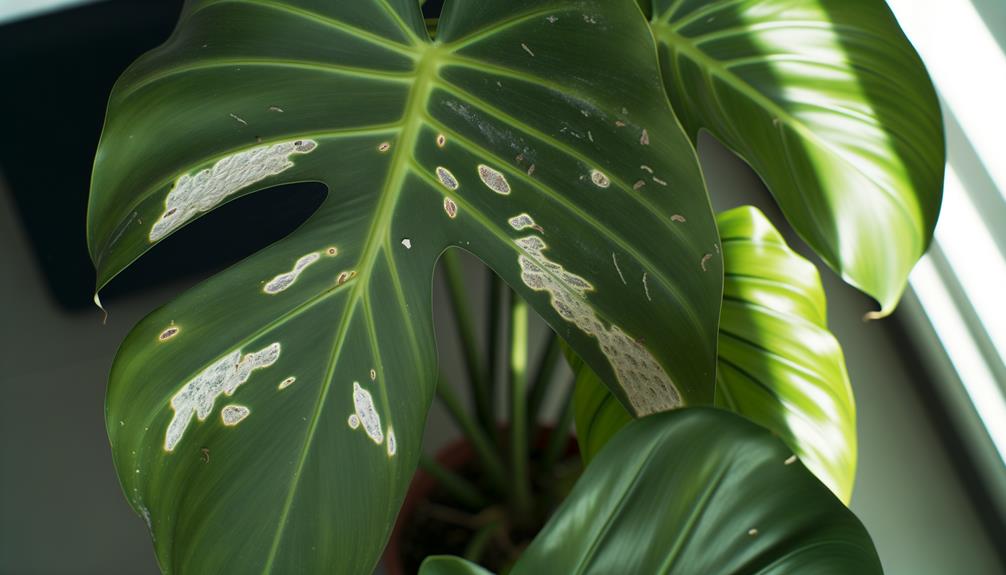
Aphids, spider mites, and scale insects are the most common pests that afflict Split Leaf Philodendron and Monstera Deliciosa, compromising their foliage integrity and overall plant health. These pests feed on the sap, causing chlorosis, stunted growth, and leaf deformation. Their presence can be identified through various symptoms:
- Aphids: Small, soft-bodied insects that excrete honeydew, leading to sooty mold.
- Spider Mites: Tiny arachnids that cause stippling and webbing on leaves.
- Scale Insects: Hard or soft-bodied pests that attach to stems and leaves, creating yellow spots.
- Mealybugs: Cotton-like pests that cluster on leaf nodes and undersides.
Effective pest management involves regular inspection, isolation of affected plants, and the application of horticultural oils or insecticidal soaps.
Toxicity to Pets
Both the Split Leaf Philodendron and Monstera Deliciosa contain insoluble calcium oxalates, rendering them toxic to pets if ingested. These plants' tissues harbor needle-like crystals called raphides, which can cause severe oral and gastrointestinal irritation.
Upon mastication, raphides penetrate mucous membranes, leading to symptoms such as drooling, vomiting, and dysphagia. Additionally, the plant's saponin content can exacerbate the irritant effects.
Morphologically, the leaves and stems of both species are the primary repositories of these toxic compounds. It is vital for pet owners to recognize these risks and implement preventive measures, such as placing the plants out of reach or opting for non-toxic alternatives.
Immediate veterinary consultation is advised upon suspected ingestion to mitigate potential health complications.
Aesthetic Appeal
The aesthetic appeal of Split Leaf Philodendron (Thaumatophyllum bipinnatifidum) and Monstera Deliciosa lies prominently in their unique leaf morphology, characterized by deeply lobed, fenestrated leaves that offer a visually striking and exotic appearance. The morphological differences contribute significantly to their ornamental value.
Thaumatophyllum bipinnatifidum features:
- Deeply lobed leaves: Intricately divided, giving a delicate texture.
- Robust structure: Strong petioles supporting large leaf blades.
- Symmetrical growth: Balanced leaf distribution enhancing visual harmony.
- Glossy surface: Reflective sheen that accentuates light.
Monstera Deliciosa, on the other hand, is known for its:
- Fenestrated leaves: Characteristic splits and holes that develop as the plant matures.
- Climbing habit: Aerial roots supporting vertical growth.
- Variable leaf size: Smaller, juvenile leaves transforming into large, mature foliage.
- Textural diversity: Smooth yet perforated leaf surfaces.
Conclusion
In summation, the split leaf philodendron and Monstera deliciosa, while sharing superficial similarities, diverge notably in leaf morphology, growth dynamics, and ecological preferences.
The intricate dance of light, water, and soil underscores their unique physiological demands.
Their susceptibility to pests and toxicity to pets further differentiates their care requirements.
These botanical marvels, each with distinct aesthetic allure, contribute uniquely to the tapestry of indoor horticulture, showcasing nature's artistry in form and function.

